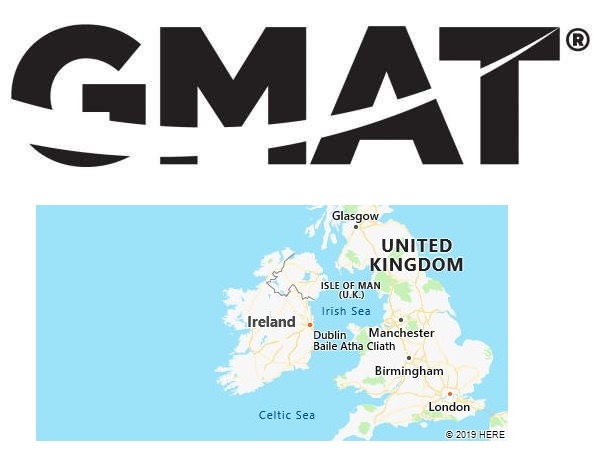GMAT Testing Location
We have found 1 GMAT test centre in Ireland, located in Dublin. For specific test dates of 2019, please refer to the end of this page.

New Horizons Ireland
Strand House
22-24 Strand Street Great
Dublin
1
Ireland
Phone: 00353 1 8898 708
Test Center Information
New Horizons is located at Strand House, 22-24 Strand Street Great, Dublin 1. We are located in the centre of Dublin and benefit from all of the main transport links that serve Dublin City Centre.
Once in Dublin City Centre New Horizons can be found between The Jervis centre LUAS stop and The Millennium Bridge. For a map of our location please go to http://www.newhorizonsireland.ie
GMAT Exam Dates in Ireland
Unlike some paper based exams, the GMAT is computer based. Therefore, there are no fixed test dates for GMAT. Wherever you are in Ireland, all test centers are open from Monday through Saturday throughout the year. Some even offer the exam every day of the year. However, some test centers are not open on Sundays and national holidays. For example, most college-based test centers might be closed for extended periods around holidays. For precise testing dates in Ireland, please visit test-maker website – https://www.mba.com/.
Politics
The constitution of 1937 (draft by Eamon de Valera , entered into force after a referendum on December 29th) defines Ireland as a parliamentary-democratic republic and contains a comprehensive catalog of fundamental rights. In 1948/49, the Republic of Ireland Act severed all links with Great Britain under constitutional law. Changes (amendments) to the constitution are possible by referendum (so far more than 20). Until the “Good Friday Agreement” (1998) and its amendment in 1999, the constitution covered the entire island of Ireland, but limited state acts of sovereignty to the territory of the Republic of Ireland. In place of the previously postulated claim to the reintegration of Northern Ireland, there was a striving for peaceful unification with the consent of both parts of the country.
The head of state is the president, who is directly elected for 7 years. In addition to ceremonial and representative functions, he holds the post of Commander-in-Chief of the Armed Forces and appoints the Prime Minister (Irish Taoiseach) on the proposal of the House of Representatives. The Taoiseach (often so called in English texts) nominates the remaining members of the cabinet, who are appointed by the President and who are responsible to the House of Representatives, with the approval of the President.
The legislature lies with the Parliament (Irish Oireachtas). It consists of the President and the bicameral parliament, which consists of the Senate (Irish Seanad Éireann, English Upper House) and the House of Representatives (Irish Dáil Éireann, English Lower House). The Senate, which has a predominantly advisory role, has 60 members who gain membership in various ways: 11 Senators are appointed by the Prime Minister, 6 are posted by graduates from the University of Dublin and the National University of Ireland, and 43 from certain professional fields. and other social groups. The House of Representatives is elected for 5 years using the proportional representation system. Their number is not fixed, but at least 1 member per 20,000–30,000 residents must be appointed.
Leo Varadkar has been the chairman of the Fine Gael party since 2017. Since, in the opinion of the population, his government was not doing enough for the health service, housing shortages and homelessness, the Sinn Féin party achieved a surprisingly high victory in the 2020 elections. As a result, an unprecedented coalition of the bourgeois parties Fianna Fáil and Fine Gael with the Greens under Fianna Fáil boss Micheál Martin has ruled as prime minister since this year. This government sees its tasks equally in the solution of urgent issues both in the social sector as well as in relation to the problems associated with that of Great Britain and Northern Ireland completed Brexit.
National symbols
The national flag is a tricolor in the vertically arranged colors green, white and orange. The colors have been shown since the start of the struggle for independence in 1830, adopted by the Irish Free State in 1922, and declared the national flag in the Constitution of the Republic of Ireland in 1937. The flag symbolizes the striving for harmony between all parts of the population: green stands for the country and the Catholic citizens, white for peace and harmony, orange for the Protestant population.
The coat of arms shows a golden harp on a blue background, based on the Brian Boru harp in the National Museum in Dublin.
March 17th commemorates the death anniversary of the Irish national saint Saint Patrick in the year 461.
Parties
The party system is still shaped by the Irish struggle for independence against Great Britain. The most influential political forces are, besides Fianna Fáil (FF; founded 1926) and Fine Gael (FG; founded 1933), which have their origins in the Irish independence movement Sinn Féin, the Labor Party (LP; founded 1912), Green Party (GP; successor party to the Ecology Party founded in 1981, Sinn Féin (SF; founded 1905) and the socialist groups People Before Profit Alliance (PBP; founded 2005) and Socialist Party (SP; founded 1996).
Unions
Around a quarter of the workers are unionized. The umbrella organization for all Irish trade unions is the Irish Congress of Trade Unions (ICTU; founded 1894).
